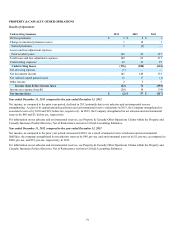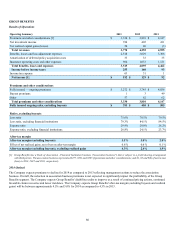The Hartford 2013 Annual Report Download - page 70
Download and view the complete annual report
Please find page 70 of the 2013 The Hartford annual report below. You can navigate through the pages in the report by either clicking on the pages listed below, or by using the keyword search tool below to find specific information within the annual report.70
Loss and loss adjustment expense ratio
The loss and loss adjustment expense ratio is a measure of the cost of claims incurred in the calendar year divided by earned premium
and includes losses incurred for both the current and prior accident years, as well as the costs of mortality and morbidity and other
contractholder benefits to policyholders.
The loss and loss adjustment expense ratio is affected by claim frequency and claim severity, particularly for shorter-tail property lines
of business, where the emergence of claim frequency and severity is credible and likely indicative of ultimate losses. Claim frequency
represents the percentage change in the average number of reported claims per unit of exposure in the current accident year compared to
that of the previous accident year. Claim severity represents the percentage change in the estimated average cost per claim in the current
accident year compared to that of the previous accident year. As one of the factors used to determine pricing, the Company’s practice is
to first make an overall assumption about claim frequency and severity for a given line of business and then, as part of the ratemaking
process, adjust the assumption as appropriate for the particular state, product or coverage. Among other factors, the loss and loss
adjustment expense ratio needed for the Company to achieve its targeted return on equity fluctuates from year to year based on changes
in the expected investment yield over the claim settlement period, the timing of expected claim settlements and the targeted returns set
by management based on the competitive environment.
Loss ratio, excluding buyouts
The loss ratio is utilized for the Group Benefits segment and is expressed as a ratio of benefits, losses and loss adjustment expenses to
premiums and other considerations, excluding buyout premiums. Since Group Benefits occasionally buys a block of claims for a stated
premium amount, the Company excludes this buyout from the loss ratio used for evaluating the underwriting results of the business as
buyouts may distort the loss ratio. Buyout premiums represent takeover of open claim liabilities and other non-recurring premium
amounts.
Mutual Fund Assets
Mutual fund assets are owned by the shareholders of those funds and not by the Company and therefore are not reflected in the
Company’s consolidated financial statements. Mutual fund assets are a measure used by the Company because a significant portion of
the Company’s revenues are based upon asset values. These revenues increase or decrease with a rise or fall in the amount of account
value whether caused by changes in the market or through net flows.
New business written premium
New business written premium represents the amount of premiums charged for policies issues to customers who were not insured with
the Company in the previous policy term. New business written premium plus renewal policy written premium equals total written
premium.
Policies in force
Policies in force represent the number of policies with coverage in effect as of the end of the period. The number of policies in force is a
growth measure used for Consumer Markets and standard commercial lines within Property & Casualty Commercial and is affected by
both new business growth and premium renewal retention.
Policy count retention
Policy count retention represents the ratio of the number of policies renewed during the period divided by the number of policies from
the previous policy term period. The number of policies available to renew from the previous policy term represents the number of
policies written in the previous policy term net of any cancellations of those policies. Policy count retention is affected by a number of
factors, including the percentage of renewal policy quotes accepted and decisions by the Company to non-renew policies because of
specific policy underwriting concerns or because of a decision to reduce premium writings in certain classes of business or states. Policy
count retention is also affected by advertising and rate actions taken by competitors.
Policyholder dividend ratio
The policyholder dividend ratio is the ratio of policyholder dividends to earned premium.
Prior accident year loss and loss adjustment expense ratio
The prior year loss and loss adjustment expense ratio represents the increase (decrease) in the estimated cost of settling catastrophe and
non-catastrophe claims incurred in prior accident years as recorded in the current calendar year divided by earned premiums.
Reinstatement premiums
Reinstatement premium represents additional ceded premium paid for the reinstatement of the amount of reinsurance coverage that was
reduced as a result of a reinsurance loss payment.
























